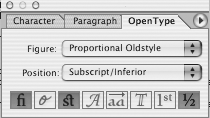14.1. Introduction
The title of this chapter refers to the "advanced typographic features" of OpenType and AAT fonts, which are tables added to the basic TrueType fonts by Microsoft, Adobe, and Apple. We have witnessed the emergence of two new font formats: OpenType (defined by Adobe and Microsoft, formerly called "TrueType Open") and AAT (for "Apple advanced typography", formerly called "TrueType GX"). Thanks to these tables, we can better meet the needs of the non-Latin scripts, in particular the Asian scripts, but also some of the requirements of traditional typography, well beyond the possibilities of the original TrueType format. Here, then, is the dialog box for OpenType in Adobe Illustrator CS2 (under Mac OS X), where the different OpenType features (default ligatures, calligraphic letters, etc.) are shown in the form of buttons that are enabled only when the feature in question is present in the font:

Whether for setting type in Sanskrit, in Urdu or Arabic with aesthetic ligatures, in Hebrew with vowel points, in Elzevirian Greek with ligatures, in calligraphic Latin, or simply in a text font with capitals and old-style figures, OpenType and AAT tables are well up to these challenges, and others as well. What is particular about these fonts is that the arrangement and substitution of the glyphs are not part of the operating system, as used to be the case, but are included ...
Get Fonts & Encodings now with the O’Reilly learning platform.
O’Reilly members experience books, live events, courses curated by job role, and more from O’Reilly and nearly 200 top publishers.

